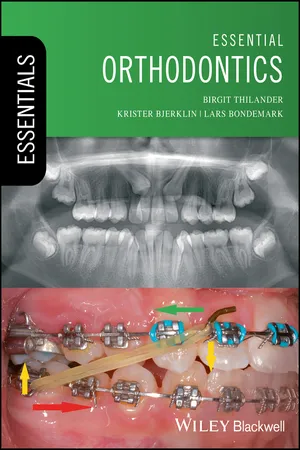
- English
- ePUB (mobile friendly)
- Available on iOS & Android
Essential Orthodontics
About this book
Essential Orthodontics is a comprehensive introduction to the biological principles of orthodontics. This book covers the why, when and how of orthodontics, enabling readers to identify which individuals need to be treated, to diagnose based on individual dentofacial development, and to understand the mechanical principles and tissue responses involved.
Divided into three parts, this authoritative resource covers pretreatment considerations, treatment principles of skeletal and dentoalveolar anomalies, and tissue response to orthodontic and orthopaedic forces. Classification of malocclusions and craniofacial growth and development are discussed, and the text explores how to distinguish between normal occlusion and malocclusions. Essential Orthodontics outlines how to perform a comprehensive orthodontic examination leading to an orthodontic diagnosis, and the formation of a treatment plan.
Following a student-friendly layout with key objectives and chapter summaries, Essential Orthodontics is an accessible yet comprehensive resource for both undergraduate and postgraduate dental students.
Frequently asked questions
- Essential is ideal for learners and professionals who enjoy exploring a wide range of subjects. Access the Essential Library with 800,000+ trusted titles and best-sellers across business, personal growth, and the humanities. Includes unlimited reading time and Standard Read Aloud voice.
- Complete: Perfect for advanced learners and researchers needing full, unrestricted access. Unlock 1.4M+ books across hundreds of subjects, including academic and specialized titles. The Complete Plan also includes advanced features like Premium Read Aloud and Research Assistant.
Please note we cannot support devices running on iOS 13 and Android 7 or earlier. Learn more about using the app.
Information
Part 1
Pretreatment Considerations
Chapter 1
Orthodontic panorama
Key topics
- The orthodontic patient
- Individuals with different demands for orthodontic treatment
- Orthodontic care systems
Learning objectives
- To be able to handle individuals with orthodontic problems
- To understand what essential orthodontics implies
Orthodontic panorama
Table of contents
- Cover
- Title Page
- Copyright
- Table of Contents
- List of Abbreviations
- Preface
- Acknowledgement
- Part 1: Pretreatment Considerations
- Part 2: Treatment Principles of Skeletal and Dentoalveolar Anomalies
- Part 3: Tissue Response to Orthodontic and Orthopaedic Forces
- Index
- End User License Agreement